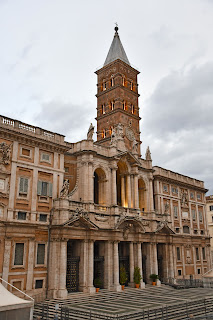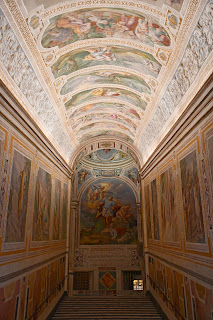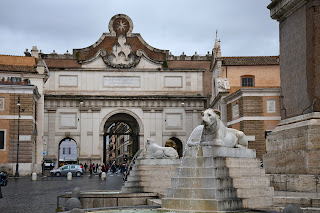Italy from South to North – Day 4: Rome and the Vatican
We began our day by buying breakfast at a nearby pastry shop, which we ate on the way to our first destination. We were not in a particular hurry, but I forgot to tell Aron this and so he ordered take-away for both of us.
Our first stop for the
day was the Archbasilica of San Giovanni in Lateran. As the seat of the bishop
of Rome (i.e., the Pope), it is the city’s cathedral, which is strange
considering the fame of Saint Peter’s (which is “only” a basilica).
Interestingly, the complex enjoys extraterritorial status from Italy thanks to
the Lateran Pacts of 1929, which were signed between Mussolini and Pius XI,
establishing Vatican City as an independent state.
The name “Lateran” is
also famous due to the many synods held there. The First Lateran Council (1123)
confirmed the Concordat of Worms, which solved the Investiture Controversy by
essentially affirming the Pope’s right to appoint bishops and abbots. It also
forbade clerics from marrying or living in concubinage. The Third Lateran
Council (1179) established rules for electing the Pope that are followed to
this day, such as election by cardinals only and by a two-thirds majority. The
Fifth Lateran Council (1512-17) famously failed to address growing popular discontent
and proved unable to stop the Protestant Reformation.
Opposite the basilica,
we also visited the Sanctuary of the Holy Stairs. The site comprises three
staircases, with the middle staircase explicitly reserved for worshippers wishing
to ascend on their knees. Along their sides and on their ceilings, the
staircases are decorated with famous scenes from the Bible, such as the loss of
paradise and the great flood. The staircase on the right spotlights the most
important moments in the lives of Old Testament figures from Abraham to Moses.
Next, we visited the
Basilica of San Clemente. Its beautiful mosaic apse is decorated with swirling
patterns, saints, and animals. At its centre stands a cross with twelve white
doves, while the bottom strip features twelve white sheep facing a haloed ram. Not
much farther away we also visited the Basilica of Saint Peter in Vincoli, which
is particularly well-known for Michelangelo’s statue of Moses. Its depiction of
the patriarch with horns reflects the Latin Vulgate translation of the Bible,
which substitutes the word “horned” for “exalted.”
Having visited four
religious buildings in the space of less than two hours, we took a short
secular break and wound our way past Trevi Fountain to the Spanish Steps and
finally to Piazza del Popolo. It is really quite remarkable how heavily Ancient
Egypt has influenced the face of Rome, with obelisks dotting a number of
squares including Saint Peter’s itself.
Since we had booked
our tickets to the Vatican Museums for one o’clock, we started to slowly make
our way to the city-state along the banks of the Tiber. We crossed the Ponte
Sant’Angelo to Castel Sant’Angelo and ate a quick lunch of pizza and tiramisu
in the neighbourhood. Although it was still only twelve, we made it into the
museums without raising a single eyebrow.
As one would expect,
the museums were impressive. We did not enter with the ambition to see every
object and indeed, we soon renounced even the daring hope that we might visit
every room in the building. Instead, we focussed on the parts we really wanted
to see, occasionally taking note of impressive artefacts and rooms along the
way. My highlight was seeing Raphael’s School of Athens, which has long been
familiar from the covers of various philosophy books. I learned that Raphael’s
depiction included not only the ancient philosophers and scientists but also
the artist himself, who gazes at the viewer with an almost cheeky expression.
Also eying the viewer is the painting’s sole prominent woman, the philosopher
Hypatia. I imagine her unique depiction may have something to do with Raphael
being quite a ladies’ man, possibly suggesting that one such lady may have
served as a model.
Upon finishing our
visit to the Vatican Museums (which of course included the Sistine Chapel with
its nearly touching fingers, the humanlike snake, the sinner’s flailed skin,
and many other familiar details), we proceeded to Saint Peter’s Square. Having
walked all the way back along the city’s massive walls, we were dismayed to
find that the queue was enormous, and more of our time would go to the dogs.
Nevertheless, the queue moved a little faster than we expected, and we found
ourselves inside the building with the sun still far above the horizon.
It would be futile for
me to attempt describing the awe that the monumental basilica inspires. Many
times over, I marvelled at the giant columns and at the even heftier structure
they support. Then, taking a closer look, I would notice soft details set
against these massive feats of engineering, like the occasional white dove on
the ceiling of a dome or in the apse’s stained glass.
We stayed at the
Vatican for almost four hours, after which we walked along the Tiber hoping to
get a few good shots of Saint Peter’s dome. Since it started raining, however,
we decided to call off the expedition and began our walk home. On our way, we stopped
by and climbed the Monument to Victor Emmanuel II, taking in the evening views
of the Trajan Forum and the lit-up Colosseum. The sounds of street musicians
playing the last part of Vivaldi’s summer came floating towards us through the
wet darkness; I could not leave the balcony until they finished.
We ate dinner at the
train station. Feeling tired of carbohydrates, I had a parmigiana and a fried
artichoke, with a cannolo for dessert.
























































Comments
Post a Comment